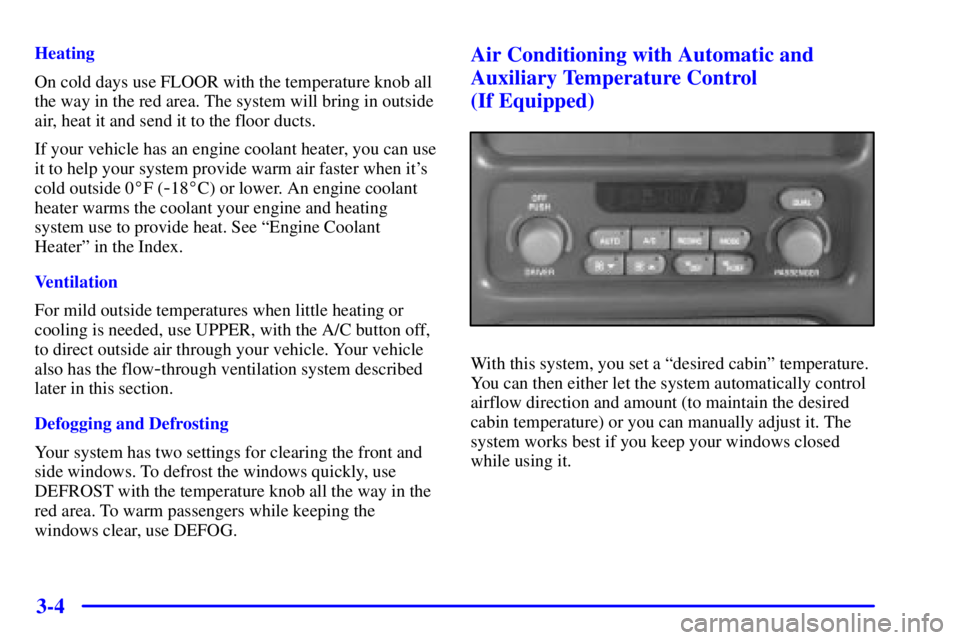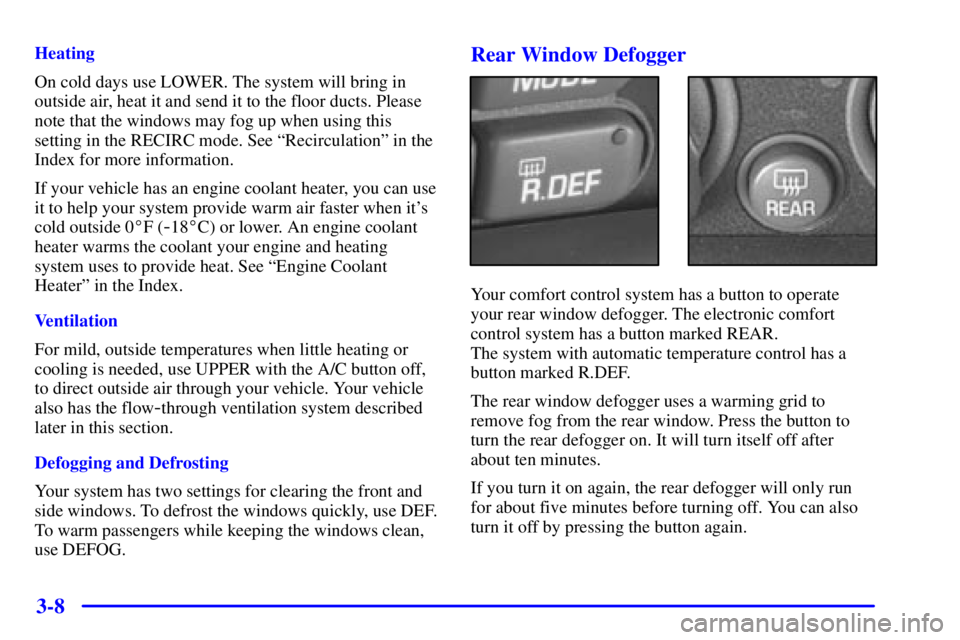Page 160 of 376

2-92 Control Buttons
The trip computer has three buttons that control
its functions.
ENG/MET: Press this button to change the display from
English to metric units or metric to English.
RESET: Press this button for two seconds to reset the
mode displayed.
MODE: Press this button to change the mode
being displayed.
Functions
PERFORMANCE SHIFT: This light comes on when
you press the performance shift button (if equipped)
located on the console shift lever to indicate that the
vehicle is in performance shifting mode.
See ªPerformance Shiftingº in the Index.
FUEL USED: Shows the total amount of fuel used
since you last reset this mode. The amount can be
displayed in gallons or liters.
AVG ECON: Shows the average fuel economy since
you last reset this mode.
OIL LIFE: Shows a percentage of the oil's remaining
useful life. The system predicts remaining oil life using
inputs from length of drives, coolant temperature,
engine rpm and vehicle speed. Each time you get an oil
change, be sure to reset this function so that it will give
you an accurate percentage. See ªHow to Reset the
GM Oil Life System�º in the Index.
Page 165 of 376

3-4
Heating
On cold days use FLOOR with the temperature knob all
the way in the red area. The system will bring in outside
air, heat it and send it to the floor ducts.
If your vehicle has an engine coolant heater, you can use
it to help your system provide warm air faster when it's
cold outside 0�F (
-18�C) or lower. An engine coolant
heater warms the coolant your engine and heating
system use to provide heat. See ªEngine Coolant
Heaterº in the Index.
Ventilation
For mild outside temperatures when little heating or
cooling is needed, use UPPER, with the A/C button off,
to direct outside air through your vehicle. Your vehicle
also has the flow
-through ventilation system described
later in this section.
Defogging and Defrosting
Your system has two settings for clearing the front and
side windows. To defrost the windows quickly, use
DEFROST with the temperature knob all the way in the
red area. To warm passengers while keeping the
windows clear, use DEFOG.
Air Conditioning with Automatic and
Auxiliary Temperature Control
(If Equipped)
With this system, you set a ªdesired cabinº temperature.
You can then either let the system automatically control
airflow direction and amount (to maintain the desired
cabin temperature) or you can manually adjust it. The
system works best if you keep your windows closed
while using it.
Page 169 of 376

3-8
Heating
On cold days use LOWER. The system will bring in
outside air, heat it and send it to the floor ducts. Please
note that the windows may fog up when using this
setting in the RECIRC mode. See ªRecirculationº in the
Index for more information.
If your vehicle has an engine coolant heater, you can use
it to help your system provide warm air faster when it's
cold outside 0�F (
-18�C) or lower. An engine coolant
heater warms the coolant your engine and heating
system uses to provide heat. See ªEngine Coolant
Heaterº in the Index.
Ventilation
For mild, outside temperatures when little heating or
cooling is needed, use UPPER with the A/C button off,
to direct outside air through your vehicle. Your vehicle
also has the flow
-through ventilation system described
later in this section.
Defogging and Defrosting
Your system has two settings for clearing the front and
side windows. To defrost the windows quickly, use DEF.
To warm passengers while keeping the windows clean,
use DEFOG.
Rear Window Defogger
Your comfort control system has a button to operate
your rear window defogger. The electronic comfort
control system has a button marked REAR.
The system with automatic temperature control has a
button marked R.DEF.
The rear window defogger uses a warming grid to
remove fog from the rear window. Press the button to
turn the rear defogger on. It will turn itself off after
about ten minutes.
If you turn it on again, the rear defogger will only run
for about five minutes before turning off. You can also
turn it off by pressing the button again.
Page 241 of 376

5-10
Engine Overheating
You will find a coolant temperature gage and a warning
light about a hot engine on your instrument panel
cluster. See ªEngine Coolant Temperature Gageº and
ªEngine Coolant Temperature Lightº in the Index.
You also have a low coolant light on your instrument
panel cluster. See ªLow Coolant Lightº in the Index.
Overheated Engine Protection
Operating Mode
This emergency operating mode allows your vehicle to
be driven to a safe place in an emergency situation.
Should an overheated engine condition exist, an
overheat protection mode which alternates firing groups
of cylinders helps prevent engine damage. In this mode,
you will notice a significant loss in power and engine
performance. The low coolant light may come on and
the temperature gage will indicate an overheat condition
exists. Towing a trailer in the overheat protection mode
should be avoided.
NOTICE:
After driving in the overheated engine protection
operating mode, to avoid engine damage, allow
the engine to cool before attempting any repair.
The engine oil will be severely degraded. Repair
the cause of coolant loss and change the oil.
See ªEngine Oilº in the Index.
Page 242 of 376
5-11 If Steam Is Coming From Your Engine
CAUTION:
Steam from an overheated engine can burn you
badly, even if you just open the hood. Stay away
from the engine if you see or hear steam coming
from it. Just turn it off and get everyone away
from the vehicle until it cools down. Wait until
there is no sign of steam or coolant before you
open the hood.
If you keep driving when your engine is
overheated, the liquids in it can catch fire. You or
others could be badly burned. Stop your engine if
it overheats, and get out of the vehicle until the
engine is cool. See ªOverheated Engine
Protection Operating Modeº in the Index.
Page 243 of 376

5-12
NOTICE:
If your engine catches fire because you keep
driving with no coolant, your vehicle can be
badly damaged. The costly repairs would not be
covered by your warranty. See ªOverheated
Engine Protection Operating Modeº in the Index.
If No Steam Is Coming From Your Engine
If you get an engine overheat warning but see or hear no
steam, the problem may not be too serious. Sometimes
the engine can get a little too hot when you:
�Climb a long hill on a hot day.
�Stop after high
-speed driving.
�Idle for long periods in traffic.
�Tow a trailer.If you get the overheat warning with no sign of steam,
try this for a minute or so:
1. If your air conditioner is on, turn it off.
2. Turn on your heater to full hot at the highest fan
speed and open the window as necessary.
3. If you're in a traffic jam, shift to NEUTRAL (N);
otherwise, shift to the highest gear while
driving
-- AUTOMATIC OVERDRIVE (D)
or THIRD (3).
If you no longer have the overheat warning, you can drive.
Just to be safe, drive slower for about 10 minutes. If the
warning doesn't come back on, you can drive normally.
If the warning continues, pull over, stop, and park your
vehicle right away.
If there's still no sign of steam, idle the engine for
three minutes while you're parked. If you still have the
warning, turn off the engine and get everyone out of
the vehicle until it cools down. Also, see ªOverheated
Engine Protection Operating Modeº listed previously in
this section.
You may decide not to lift the hood but to get service
help right away.
Page 244 of 376
5-13
Cooling System
When you decide it's safe to lift the hood, here's what
you'll see:
3100 V6 Engine
A. Electric Engine Cooling Fans
B. Radiator Pressure Cap
C. Coolant Recovery Tank
3800 V6 and 3800 V6 Supercharged Engines
A. Electric Engine Cooling Fans
B. Radiator Pressure Cap
C. Coolant Recovery Tank
Page 245 of 376
5-14
CAUTION:
An electric engine cooling fan under the hood can
start up even when the engine is not running and
can injure you. Keep hands, clothing and tools
away from any underhood electric fan.
If the coolant inside the coolant recovery tank is boiling,
don't do anything else until it cools down.
When the engine is cold, the coolant level should be at
or above the COLD mark on the coolant recovery tank.
If it isn't, you may have a leak in the radiator hoses,
heater hoses, radiator, water pump or somewhere else in
the cooling system.